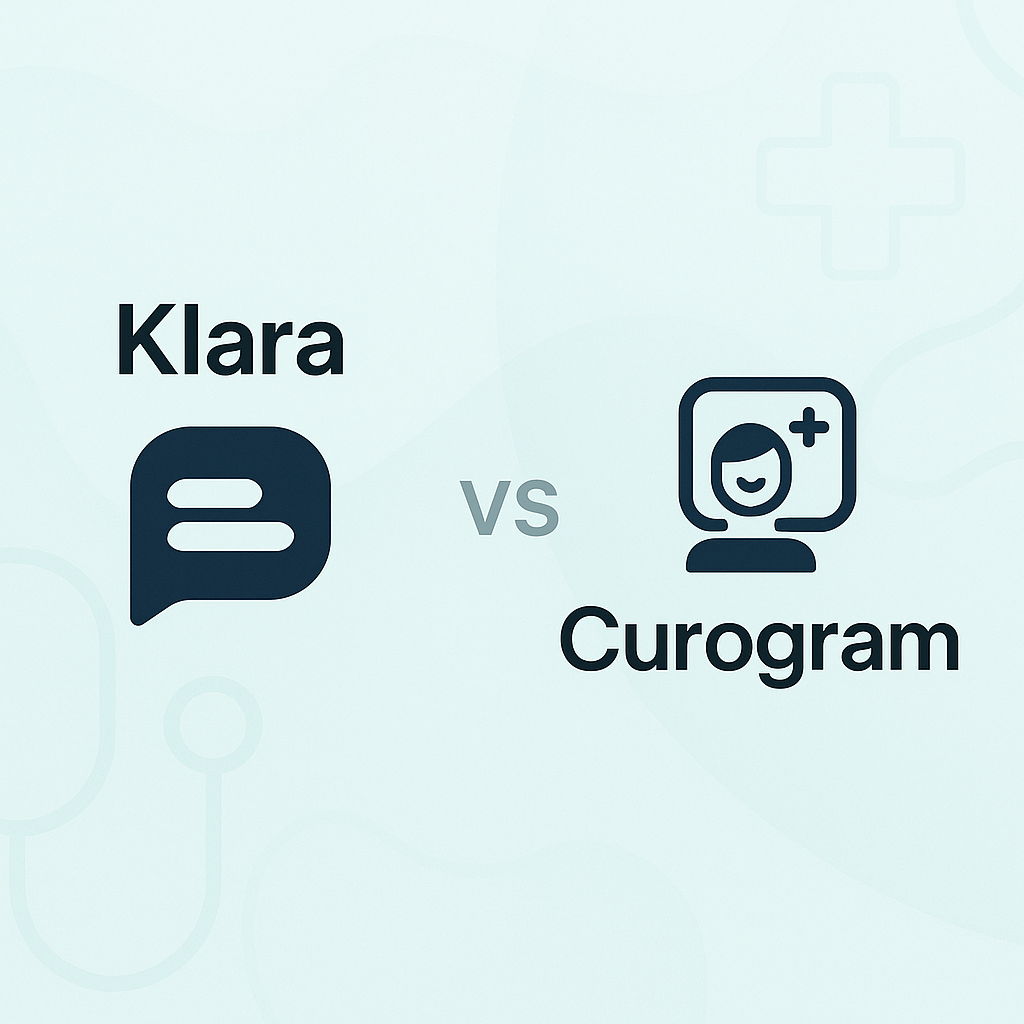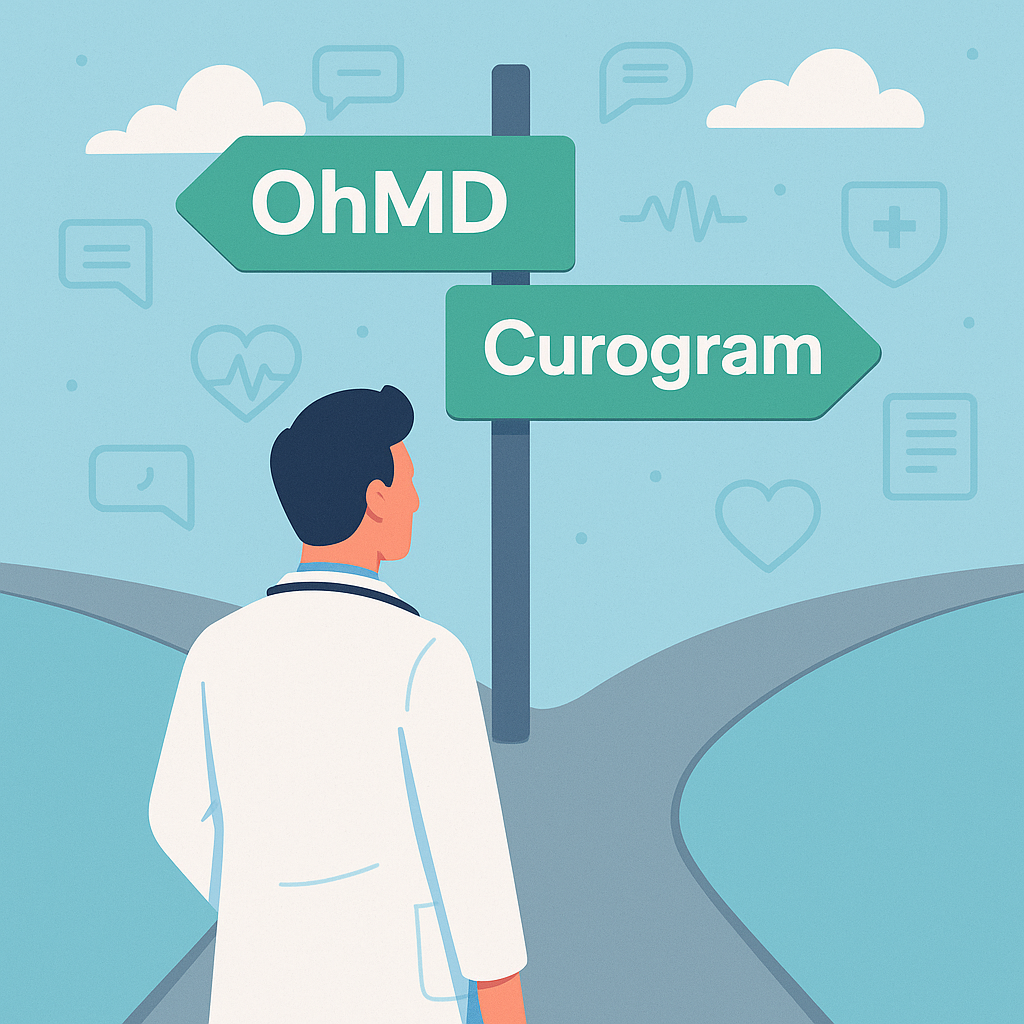OhMD Pricing vs. Curogram: Which Patient Communication Platform Offers Better Value in 2025?
Understanding the costs of patient communication platforms is essential for healthcare practices. OhMD offers several pricing tiers, including a free...

Choosing the right patient engagement platform is a critical decision for any modern medical practice. It impacts not only your budget but also your staff's efficiency and the overall patient experience. Two of the leading contenders in this space are Klara and Curogram. While both offer a suite of tools to streamline communication, their approach to pricing and feature sets have key differences.
This guide breaks down the pricing models of both platforms to help you determine which offers the best value for your practice's specific needs.
Here’s a breakdown of the key differences between these two patient communication platforms:
Klara is best for healthcare teams looking for a streamlined messaging hub with a heavy emphasis on internal collaboration and patient text messaging. It stands out with its conversation-based interface, allowing practices to keep all communications—whether with patients, staff, or external providers—in one centralized thread. It's a good fit for clinics that prioritize reducing phone calls and want a clean, modern user interface without a ton of bells and whistles.
Curogram is best for clinics seeking a fully integrated, all-in-one communication and workflow solution. With HIPAA-compliant 2-way texting, mass texting, smart appointment reminders, customizable electronic forms, automated review requests, intake forms, telemedicine, and robust EMR syncing, it’s tailored for clinics that want to scale operations, automate engagement, and improve patient satisfaction—all without needing extra tools or systems.
The fundamental difference between Klara and Curogram's pricing is in their core philosophy. Klara often bundles its features into a comprehensive, all-in-one package, which can be ideal for larger practices seeking a single, robust solution. Curogram, while also offering customized plans, is often highlighted for its flexibility and a la carte feature options, which can be more approachable for small to mid-sized practices. Curogram has a reported starting price of around $125/month, while Klara's entry point is not publicly disclosed and requires a direct quote.
| FEATURES | Klara | CUROGRAM |
|---|---|---|
| HIPAA-Compliant Texting | ✅ | ✅ |
| Two-Way SMS Texting | ✅ | ✅ |
| Telehealth Capabilities | ✅ | ✅ |
| EMR/EHR Integration | ✅ | ✅ |
| Virtual Waiting Room | ✅ | ✅ |
| Mass Messaging | ✅ | ✅ |
| Open APIs | ❌ | ✅ |
| Reputation Management | ❌ | ✅ |
| FEATURE/ASPECT | Klara | CUROGRAM |
|---|---|---|
| Primary Focus | All-in-one patient communication, team collaboration | All-in-one patient engagement, EMR integration |
| Pricing Model | Fully Custom/Quote-Based | Typically starts at $125 with added flexibility |
| Known Cost | Requires direct sales quote | Starting at $125/month (with custom pricing) |
| HIPAA Compliance | Yes | Yes |
| EMR Integration | Lists specific EHR integrations | Emphasizes seamless integration with ANY EMR/EHR |
| Key Features | Texting, Video Visits, Team Collaboration Tools | 2-Way Texting, Reminders, Forms, Telemedicine, Reputation Management |
| SOC 2 Type 2 Certified | No | Yes |
Klara's pricing model is entirely quote-based. The investment required will depend on several factors unique to your practice, including:
To understand the cost for your clinic, you must engage with their sales team for a personalized demo and quote.
| Pros | Cons |
|
|
|
|
|
|
Curogram also provides customized pricing but is more transparent about its starting point. This approach allows practices to build a plan that aligns closely with their immediate needs and budget starting at $125, with the ability to scale up as required.
Curogram's model is built on providing flexibility. Practices can often start with a core set of features and add more advanced capabilities like reputation management or sophisticated scheduling automation as they grow. This "pay for what you use" model is a significant draw for many.
| Key Features | Other Notable Features |
|
|
|
|
|
|
|
|
|
Curogram often emerges as the higher-value option for several reasons. Its flexible, scalable pricing model means practices are not forced into paying for a comprehensive, and potentially more expensive, package if they only need specific functionalities. The reported lower entry-level cost makes it more accessible for smaller practices to digitize their patient communication.
Furthermore, Curogram's patented ability to integrate with any EMR/EHR system provides a seamless workflow and eliminates the data silos that can occur with less adaptable platforms. By focusing on core, high-impact features like 2-way texting and automated reminders that directly address major practice pain points—like phone call volume and no-shows—Curogram delivers a faster and more tangible return on investment. The inclusion of Open APIs and SOC 2 Type 2 certification also highlights a commitment to security and interoperability that is critical for modern healthcare providers.
Both Klara and Curogram are excellent platforms that can revolutionize a practice's operational efficiency and patient communication. Klara offers a robust, unified system that is attractive to practices looking for a single, comprehensive solution. However, for practices seeking flexibility, transparent pricing, and a high-impact feature set that delivers immediate value, Curogram presents a compelling case. Its scalable model ensures that practices of all sizes can access powerful communication tools without over-investing in unnecessary features.
Disclaimer: The information presented in this comparison is based on publicly available data, reviews, and user testimonials as of early 2025. Pricing for both Klara and Curogram is customized and subject to change. For the most accurate and up-to-date pricing, please contact the vendors directly.

Understanding the costs of patient communication platforms is essential for healthcare practices. OhMD offers several pricing tiers, including a free...

On the surface, scheduling patients might look like a basic administrative task. But for many small clinics, it's often perceived as a permanent...

💡Poor communication can cost your healthcare practice hundreds of thousands annually. No-shows, wasted staff hours, compliance risks, and patient...